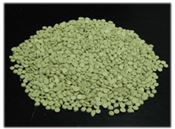Sulfur Fertilization For Rice Production

Elemental sulfur fertilizer (0-0-0-90S).
DR. DUSTIN HARRELL
RAYNE, LA.
Sulfur is an important plant essential nutrient needed for rice growth and development. Sulfur is a component of many plant enzymes and proteins. A soil test is a very good tool to determine if sulfur is limiting in your soil and if you need to apply sulfur fertilizer to maximize rice yields. Currently, the LSU AgCenter uses the Mehlich-3 soil test extraction to estimate how much sulfur is available in the soil and how much sulfur fertilizer will need to be applied to maximize yield. The sulfur soil test table can be found in the Rice Varieties and Management Tips publication and can be used to generate fertilizer recommendations from any soil testing laboratory using the Mehlich-3 soil test. In general, if the soil test results indicate that the soil is low or medium in sulfur then 40 or 20 pounds of sulfur is recommended, respectively.
Sulfur must be in the sulfate form (SO4-2) to be utilized by plants. Ammonium sulfate, zinc sulfate, and other sulfate fertilizers are excellent sources of sulfur. However, elemental sulfur (S2) fertilizer (commonly 0-0-0-90 S) is not a good fertilizer source to use in-season for rice because the sulfur is not in an immediately available form. Elemental sulfur must be converted to the sulfate form before it can be taken up by rice roots. This conversion is called sulfur oxidation and it is done by sulfur oxidizing bacteria. Oxygen is required to make the conversion. Once rice is flooded, generally, very little elemental sulfur will be converted into sulfate sulfur due to the lack of oxygen.
In upland conditions, elemental sulfur oxidation to sulfate sulfur is a very slow process. The conversion can be influenced by several factors, including the size of the fertilizer (powdered will be oxidized faster than pastilles), temperature, soil type, soil pH, soil water content, oxygen availability, and the amount of sulfur oxidizing bacteria in the soil. Elemental sulfur fertilizers are often made into pastilles (see picture) which contain a small amount of clay added to enhance dispersion and speed oxidation. Nonetheless, even in upland conditions, elemental sulfur pastilles will still be slow to oxidize. For example, one study illustrated that for a fertilizer size similar to the one in the picture, only 2% of the elemental sulfur would be converted in one month. Therefore, applications of elemental sulfur for rice in-season for a soil that is deficient in sulfur is not recommended. Applications of elemental sulfur are recommended in the fall and winter to bring soil test sulfur levels up and also to help lower soil pH. ∆
DR. DUSTIN HARRELL: Professor/Research Coordinator, LSU AgCenter